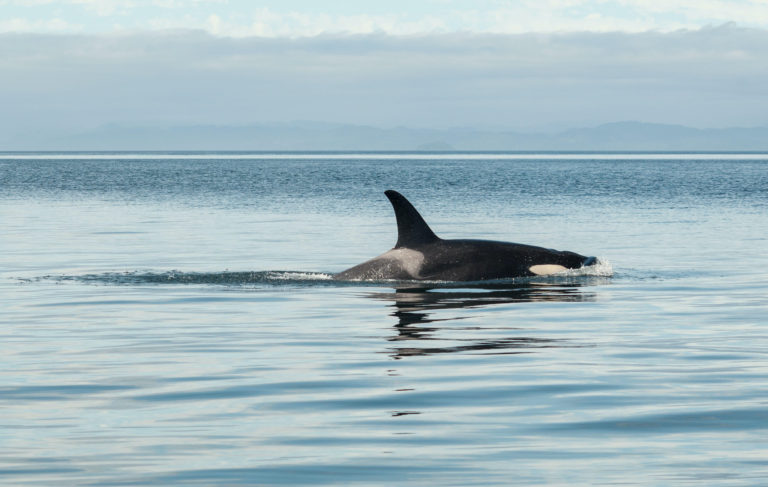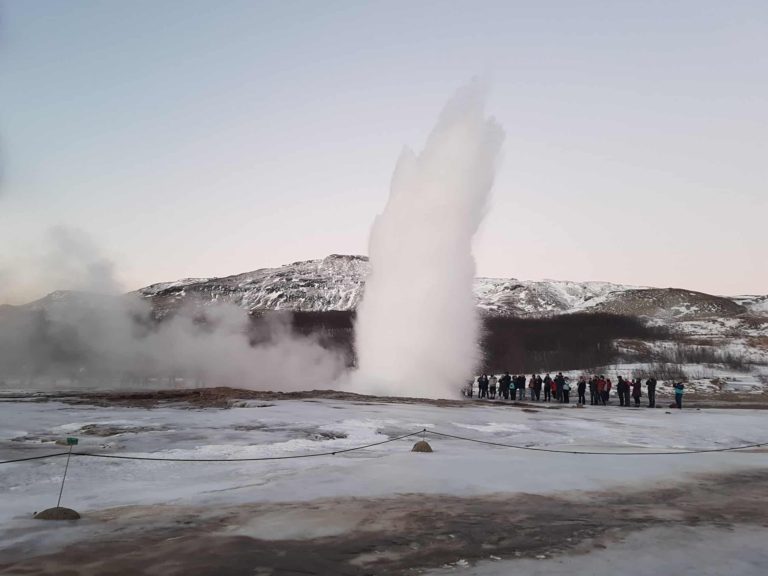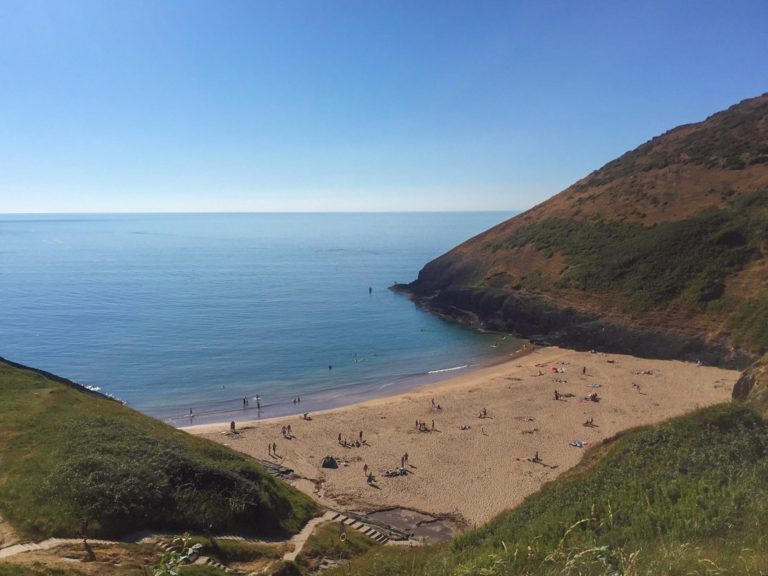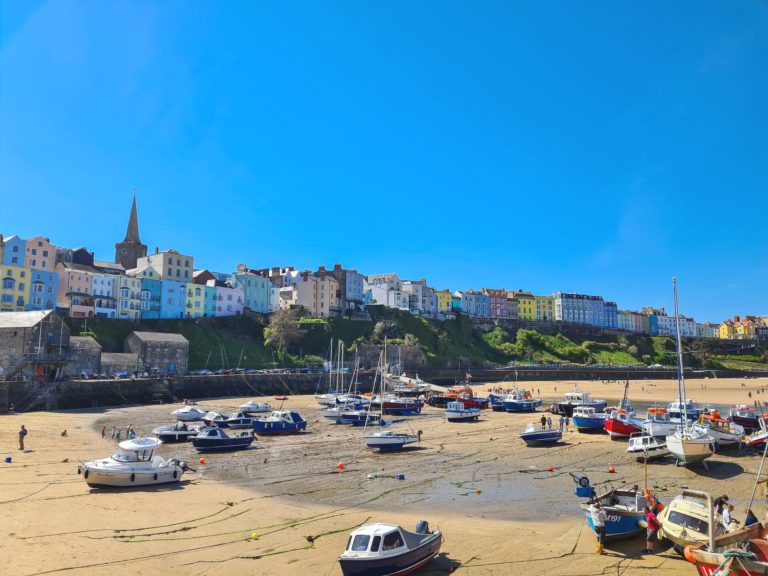The Thorough Guide to Iceland
The 31 Best Places to visit in Iceland this Winter, plus an interactive map, places to eat, where to stay, things to know before you go and more!

This post may contain affiliate links, which means we might earn a small commission on anything purchased through these links at no extra cost to you. Learn more on our disclaimer page.
Iceland, the land of ice and fire, boasts a rugged landscape teeming with volcanoes spewing lava, icy glaciers, gushing waterfalls, lush valleys and cute Icelandic horses. Home to some of Game of Thrones’ most impressive filming locations, Iceland is a must-see destination for every traveller. The best time to visit Iceland is in Winter when the landscapes are blanketed in snow and the whole country becomes a magical wonderland. Whether you have a few days to enjoy an intimate city break or a few weeks to road trip this vast island, one thing’s for sure, you won’t be bored here and you won’t leave disappointed.
Choosing between all the many Iceland Tours available can be overwhelming. We’ve trawled the internet for the very best, most popular and highly-rated Iceland tours and have put them into this article for you. Whether it’s chasing the Northern Lights, observing impressive waterfalls, or taking on an exciting adrenaline-inducing activity – Iceland has it all!
Time needed: 7-21 days.
When to go: Late November-December for the Northern Lights and snow / June-July for warmer weather and to see the Midnight Sun.
Weather: Averages of -10°C-5°C in the Winter and 8°C-20°C in the Summer.
Language: Icelandic.
Currency: Icelandic króna.

Things to do
1) Spot the Northern Lights
Possibly the number one reason for visiting Iceland, the Northern Lights are a once-in-a-lifetime experience. This dazzling celestial display, also known as the Aurora Borealis, is actually the result of disturbances in the magnetosphere caused by solar wind and can be seen in the polar regions. To see the Northern Lights in Iceland, you’ll need to visit during Winter, which falls between September and April each year.
If you’ve hired a car, it is possible to see the Northern Lights on a self-drive tour. You’ll need to research the best spots to see the northern lights in Iceland and then drive out there and wait. If you’re searching from Reykjavík, the Grótta Nature Reserve on the tip of Seltjarnarnes Peninsula is a good place to try.

Of course, seeing this spectacular phenomenon relies on the weather – you need a clear night sky with no cloud cover. You also need to be away from any towns that could emit light pollution. The best time to see the northern lights in Iceland is late at night into the early hours of the morning.
We recommend downloading an Aurora app to be up-to-date on the best conditions, locations and times to see the lights during your trip. You can turn on notifications to be notified of spikes in activity in your location too.
If you don’t have a car, your best chance of seeing the Aurora Borealis is on a Northern Lights Tour. Your tour guide will be able to take you to the best location for seeing the lights and will point out what you’re looking for. Many people expect the lights to appear as vibrant and colourful as on TV, but this isn’t always the case. Unless you get lucky with super strong activity, the dancing lights appear grey with tinges of colour to the naked eye. Don’t forget your camera and tripod if you’re keen to capture them at their best – you’ll need to take a long exposure photograph for the greens and purples to show.

Looking for an affordable package holiday to Iceland from the UK?
Consider booking a holiday to Iceland with TUI. We spent 5 nights in Reykjavík with TUI and had the most amazing time. All TUI’s packages are ATOL-insurance protected and provide incredible value for money. They offer a large range of thrilling excursions, from snowmobiling on a glacier to bathing in geothermal pools, to ensure you have the best possible holiday to Iceland.
2) Visit the Capital
You can’t visit Iceland and not visit Reykjavík. A 45 minute drive from Keflavík International Airport, the capital city of Iceland is believed to be the location of the first permanent settlement in the country. Nowadays it’s one of the trendiest capital cities in Europe and perfect for a city break. Literally translating to Smokey Bay, this cool city is surrounded by snow-capped mountains and home to under just 150,000 inhabitants. From world-renowned cultural and historical attractions to a vibrant art and music scene, Reykjavík has so much to offer you’ll want to return before your trip has come to an end.

A few of the unmissable attractions in Iceland’s capital, Reykjavík, include:
- Hallgrímskirkja
- Sólfar (The Sun Voyager)
- Lake Tjörnin
- Harpa Concert Hall
- The National Museum of Iceland
One of the best ways to see a new city is by walking around it. We’re big fans of walking tours, and there’s no better way to see Reykjavík’s main attractions than on this Walking Tour of Reykjavík with a Viking! A fun way to orient yourself in a new city, this tour is a great way to see all the best sites in Reykjavík, as well as learn about Iceland’s history, myths and legends, and get all the best restaurant recommendations from a local.
If you’re on a budget, check out our interactive map of Reykjavík in this article. We’ve pinned all the main sites as well as food and drink recommendations and everything else you need to make a DIY self-walking tour.
Find out more in The Thorough Guide to Reykjavík




3) Tour the Golden Circle
You cannot visit Iceland without getting out into the countryside and experiencing Iceland’s rugged landscapes. A 190-mile (300km) circular route, Iceland’s Golden Circle encompasses three of Iceland’s most popular natural attractions and can be completed in one day. A trip around the Golden Circle includes watching boiling water explode from a geyser in the Geothermal Hot Spring Area, taking in one of the best waterfalls in Iceland at Gullfoss and walking between tectonic plates at Þingvellir (Thingvellir) National Park.
If you have your own car, you can drive the route yourself! Check out our Self-drive Golden Circle Road Trip Itinerary with a handy map of all the main spots along the route and concise directions, as well as important road safety information.
If you don’t have access to a car, you’re going to want to consider a tour – but don’t worry, they’re super affordable! A Full Day Golden Circle Tour typically costs about £55/$60 and includes the three classic stops and a knowledgeable local guide who can give you so much interesting commentary on Iceland’s history, local legends and landscapes.
Then there are all sorts of optional extras you can add, from snowmobiling to meeting Icelandic Horses at a Tomato Greenhouse, which are sure to make your experience unforgettable! Consider these combined Golden Circle Tours:
- Golden Circle with Snowmobiling on a Glacier
- Golden Circle and Northern Lights Tour
- Golden Circle with Iceland’s Blue Lagoon
And if you’re looking for a truly unforgettable experience on a bigger budget, consider these tours:



Read next: The Thorough Guide to Iceland’s Golden Circle
4) Kerið Crater
A popular addition to the traditional Golden Circle Route, Kerið (Kerid) Crater is a volcanic crater lake located in the Grímsnes area in Southern Iceland. Famous for the vibrant blue colour of the water, the caldera is approximately 6,500 years old. The vibrant blue colour of the lake within comes from the minerals in the water, while the surrounding soil is composed of a rusty red (rather than black) volcanic rock.
Landowners charge an entrance fee to see the crater of 400ISK (£2.50/$), but you can see it for no extra cost as part of a Golden Circle Tour.
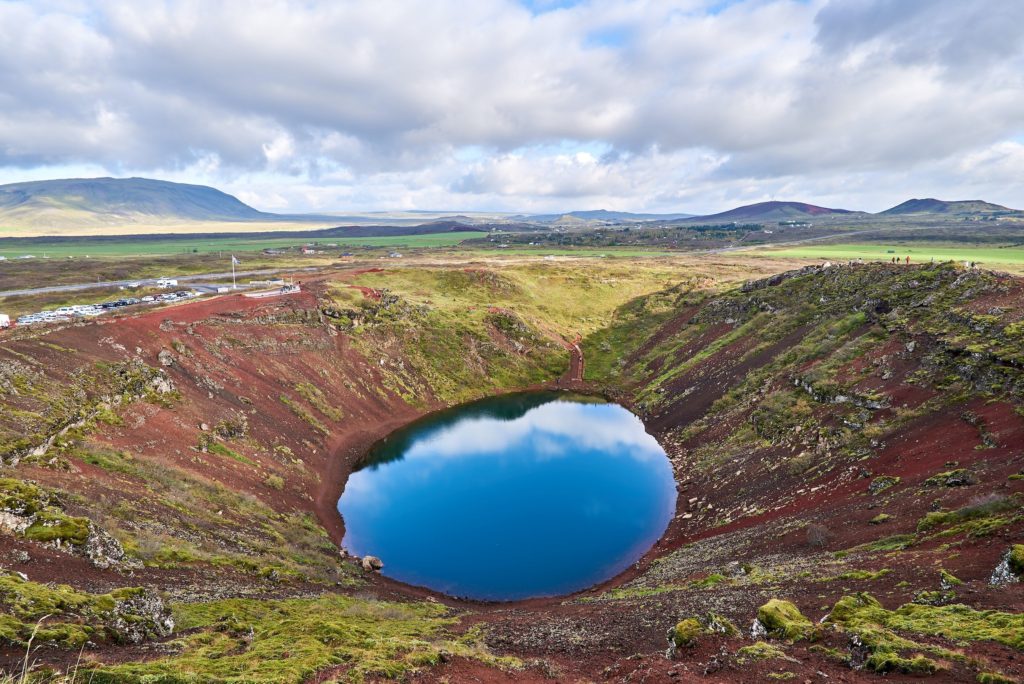
5) Bathe in the Blue Lagoon
A popular day trip from Reykjavik, Iceland’s Blue Lagoon is the place you’ve probably seen on Instagram. Containing 9 million litres of seawater, the Blue Lagoon is a man-made geothermal spa. The water is supplied by the nearby Svartsengi geothermal power station and is a milky blue shade as a result of the way the silica reflects sunlight. The water’s temperature is a glorious 38°C (100°F) and is also rich in salts and algae.
Conveniently situated 40 minutes from Reykjavík, the Blue Lagoon offers a variety of packages from comfort to luxury and premium. If you have a car you can simply drive there and park in the car park, free of charge.
We wouldn’t recommend taking a taxi as the journey alone will set you back over $100 (yep, Iceland is expensive!). Buses to and from the lagoon are organised by Destination Blue Lagoon. To visit the Blue Lagoon yourself, you’ll need to pre-book your ticket and then book your bus transfer separately. Be sure to arrive at the bus stop at least 15 minutes before your bus is scheduled.
If you don’t want to faff around with bus timetables, you can book a Blue Lagoon pick-up and drop-off service, which will come right to the door of your hotel.
Pro-tip: Tie in your visit to Blue Lagoon with your transfer to or from Keflavík International Airport! This way you can save money on transport. The Blue Lagoon pick-up and drop-off service serves both Reykjavík city and the airport.
As one of the best things to do in Iceland, there are a lot of very overpriced Blue Lagoon Tours. We’ve shown you above that it’s totally possible to visit on your own or with transport, but if you’re keen to take a tour, we’d recommend taking a combined tour with the Golden Circle and Kerid Crater.
Book your Blue Lagoon Entry Ticket with Drink, Towel, and Mud Mask here!

6) Relax in Quieter Geothermal Pools
If you’re keen to experience the wonders of bathing in geothermal waters, without the crowds that can gather at the Blue Lagoon, we’ve got you covered.
Opened in 2021, Sky Lagoon is a newcomer to Iceland’s Geothermal Pool competition, but a strong contender with the Blue Lagoon. Offering views of Snæfellsjökull (a glacier-capped volcano) and Keilir mountain, and only a short drive from downtown Reykjavík, Sky Lagoon is the perfect place to relax and experience the traditional healing powers of warm water, cold water, warm steam, dry heat and fresh air in the 7-step healing ritual.
Buy your Sky Lagoon Entrance Pass With 7-Step Spa Ritual here!
Don’t have a car? No problem. The Sky Lagoon Entry Ticket with Round-trip Transfers is the perfect way for you to visit.
Vök Baths opened in 2019 on Lake Urriðavatn in East Iceland and is the only place in Iceland featuring floating infinity pools. It also boasts two on-shore hot pools, a sauna, a cold water spray tunnel, a tea bar, an in-water pool bar, and an on-site restaurant, making it the most popular geothermal experience in East Iceland.
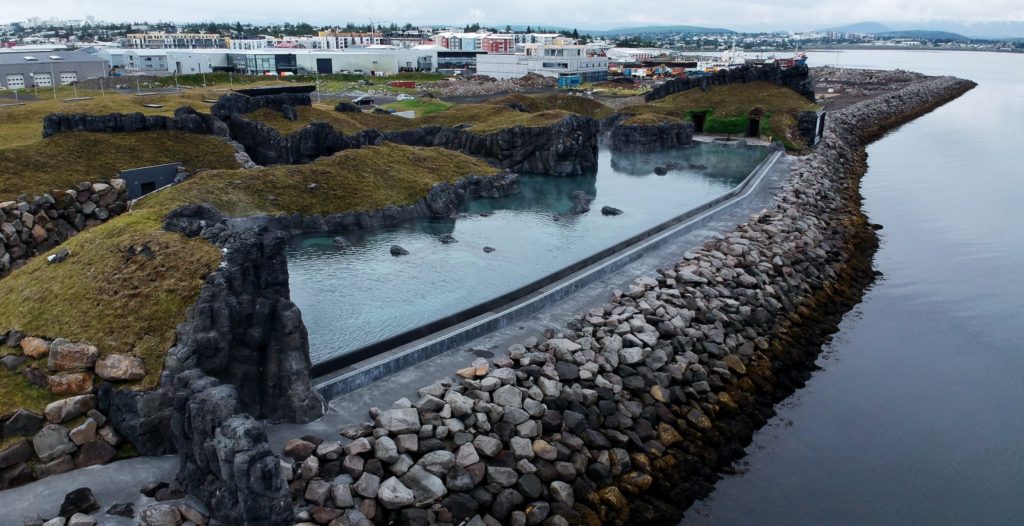
If you’re keen to leave the city and discover smaller, but quieter geothermal pools, consider these options:
Gamla Laugin Secret Lagoon is the oldest swimming pool in Iceland. Made in 1891, water trickles from hot springs and geysirs into warm pools, perfect for those looking to wind down.
Only an hour’s drive from Reykjavík, Krauma Geothermal Baths offers six baths, five warm and one cold, as well as a relaxation room and restaurant. The water originates in Deildartunguhver, Europe’s most powerful hot spring.
Laugarvatn Fontana Geothermal Baths is located in the heart of the Golden Circle. Featuring a natural pool, steam rooms and fresh-water lake, this spa is the perfect Nordic getaway spot.
Buy Your Entry Ticket to Laugarvatn Fontana Geothermal Baths here!
Located near the northern town of Húsavík, guests are spoilt at the relatively new Geosea Geothermal Sea Baths. Offering multiple infinity-edged pools and a built-in waterfall, as well as a swim-up bar and dining terrace, this is the best geothermal spa in northern Iceland.
Set at the foot of Eyjafjallajökull Volcano, Seljavallalaug is a protected 25-metre outdoor pool. It was buried by the eruption in 2010, but volunteers banded together to clear it of ash and return it to the hidden gem it was when it was built in 1923. Unlike most of Iceland’s Geothermal Pools, Seljavallalaug is free to enter!
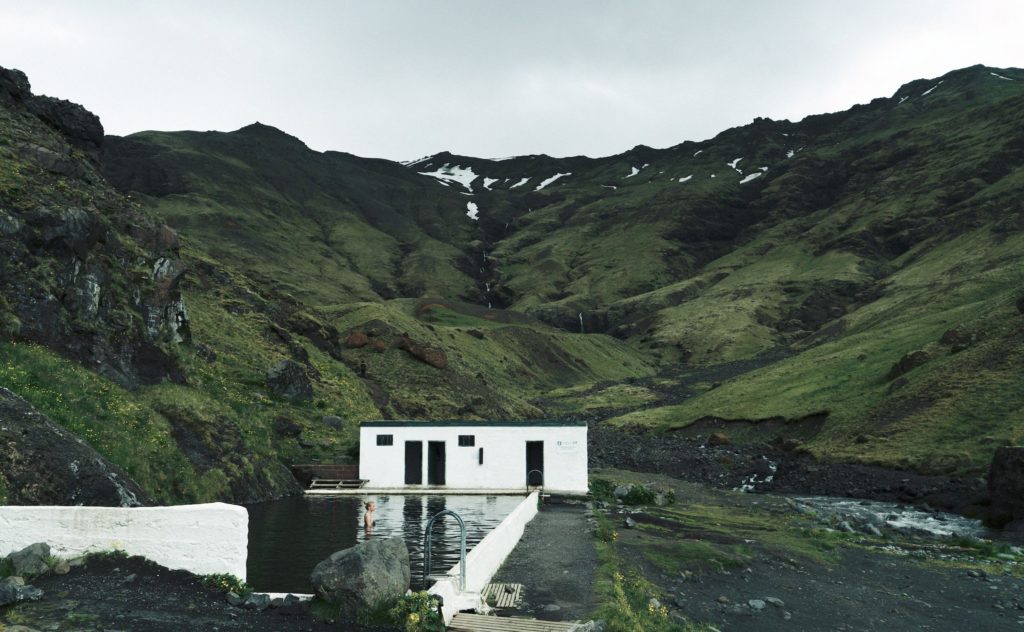
7) Lake Mývatn Geothermal Area
A Blue Lagoon dupe, Mývatn Nature Baths features similar milky-blue waters in a beautiful lagoon, with a swim-up bar and steam baths. Located within Lake Mývatn Geothermal Area – a natural attraction and the location of many Game of Thrones scenes – the area also features impressive landscapes, hot springs, volcanic craters, geothermal activity and lava fields. You can buy your Entry Ticket for Mývatn Nature Baths here!
Highlights of the Lake Mývatn Geothermal Area include Goðafoss Waterfall, the Dimmuborgir lava formations (also called the Black Fortress), pseudo-craters of Skútustaðagígar, the Hverir mud pools and Grjótagjá rift – the lava cave where that scene between Jon Snow and Ygritte was filmed. You can visit on a day tour from the northern town of Akureyri, which is only an hour’s drive from the lake.
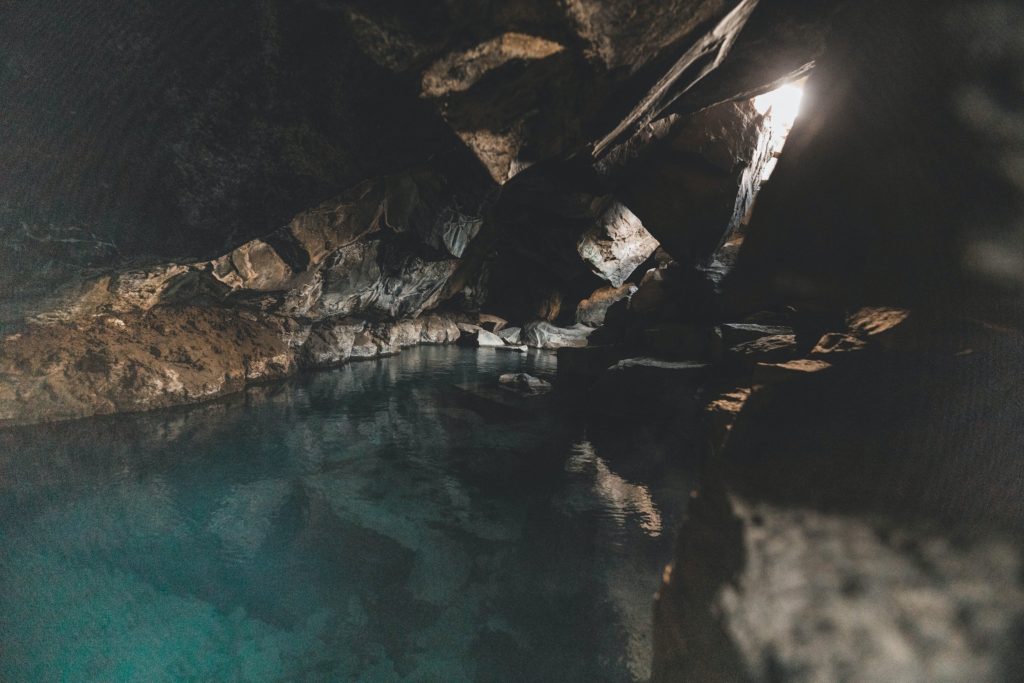
8) Visit the Waterfalls
The combination of Iceland’s cold, wet climate and the large amount of rain and snow which accumulates in the form of glaciers results in a spectacular amount of water winding through gorges as rivers and cascading over the landscape in the form of waterfalls (foss in Icelandic). Each fall is unique in shape, size, sound and surrounding natural features and many come with their own myths and legends too. There are over 30,000 waterfalls in Iceland and a lot of them are becoming increasingly popular tourist spots, with busloads of people arriving to get that perfect Instagram shot. We’ve already mentioned Gullfoss, but a few other popular falls include:
Seljalandsfoss – Part of the Seljalands River that has its origin in the volcano glacier Eyjafjallajökull, Seljalandsfoss is unique as you can actually walk behind the falls! Only a 10-minute drive from Skógafoss, there’s no reason not to tick this cascade off your list. It’s free to see, but there’s a small fee for the car park.
Skógafoss – One of the biggest waterfalls in Iceland, this 25-metre (82ft) wide and 60-metre (200ft) tall cascade is one of the most popular Instagram spots in Iceland. You can access the waterfall from above and below for free and you’ll often find rainbows dancing in the splash at the bottom.
Morsárfoss – Iceland’s tallest waterfall, here you can continue along the same track as the one which leads to Svartifoss and hike over the glacier. This should only be attempted with experienced guides and specialist equipment
Book a Southern Iceland Day Tour and marvel at Seljalandsfoss and Skógafoss as you transit between some of Iceland’s most famous sights.
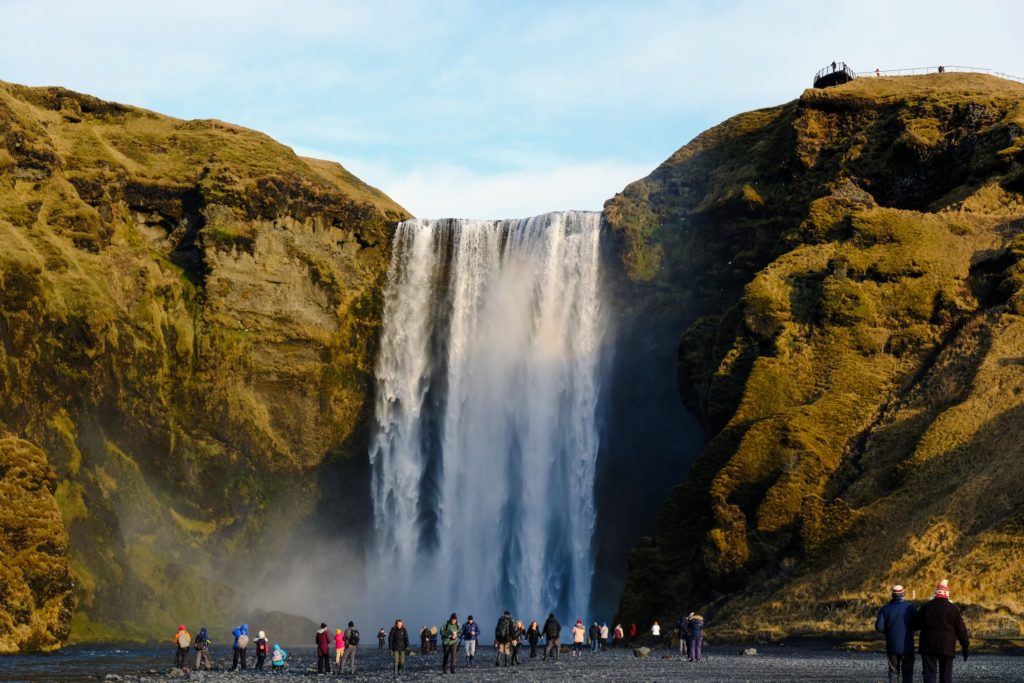
9) Hike on a Glacier and Explore Ice Caves
Iceland isn’t nicknamed the Land of Ice and Fire for nothing. Around 10% of the country is covered in dense ice, constantly moving (albeit incredibly slowly) under its own weight: glaciers.
Vatnajökull National Park is the best place to experience this icy wilderness, with countless ice caves, snowy mountain peaks, active geothermal areas, rivers, lagoons and the iconic Svartifoss and Dettifosis waterfalls. Here you can hike over Europe’s Largest Glacier and explore a crystal ice cave with a local guide.
Vatnajökull National Park is also home to the Skaftafellsjökull and Svínafellsjökull glaciers, which can be found in Skaftafell Nature Reserve. Skaftafell is the gateway to the park and the easiest entrance if you’re driving yourself there.
From Gullfoss, you can join a snowmobile tour to the Langjökull Glacier, the second-largest ice cap in Iceland.
And if you’re staying in Vík, you should consider visiting Mýrdalsjökull Glacier and Katla Ice Cave on a Jeep Tour. Sitting atop the explosive volcano, Katla, this glacier is the fourth largest and most southernly in Iceland.
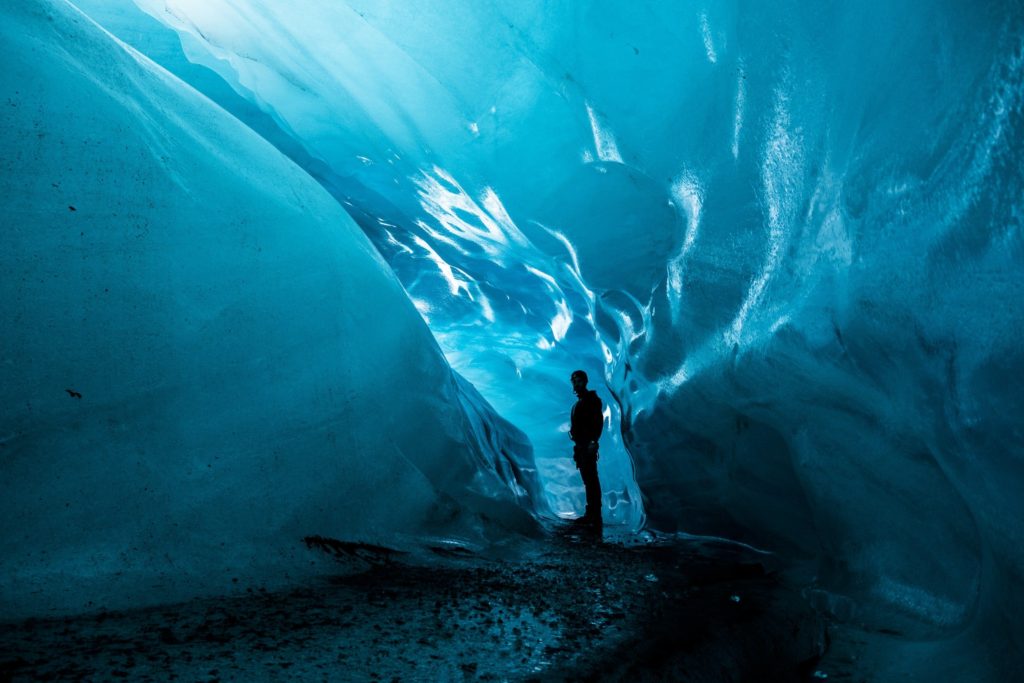
10) Boat on a Glacial Lake
No trip to Vatnajökull National Park would be complete without seeing the Jökulsárlón Glacier Lake. Featuring icy blue water, which flows towards the Atlantic Ocean, and surrounded by snowy peaks and huge icebergs, you might recognise this iconic spot from the James Bond films Die Another Day and A View to a Kill.
You can park in the official car park and take a boat trip out on the lake for the best views. If you don’t have your own transport, you can join a day tour to Jökulsárlón Glacier Lagoon from Reykjavík. Keep an eye out on your visit, as the lagoon is a great place to spot groups of seals swimming among the icebergs.

11) Visit Diamond Beach
A 2-minute drive from Jökulsárlón Glacier Lagoon lies the Southern Coast of Iceland and another of the country’s most popular Instagram spots: Diamond Beach. Boasting striking volcanic black sand, Diamond Beach is famed for the glistening iceberg fragments that drift ashore from the ocean. This is also a great place for wildlife lovers who can spot seals on the beach and orca can be spotted out to sea.
Caution should be taken on all of Iceland’s beaches, as the tides are strong and tourists have been washed out to sea by sneaker waves. Care should also be taken with the razor-sharp icebergs and you should keep your distance as they can flip and change direction quickly. There aren’t many tours specifically to Diamond Beach, but it is included in day tours of Southern Iceland like this one.
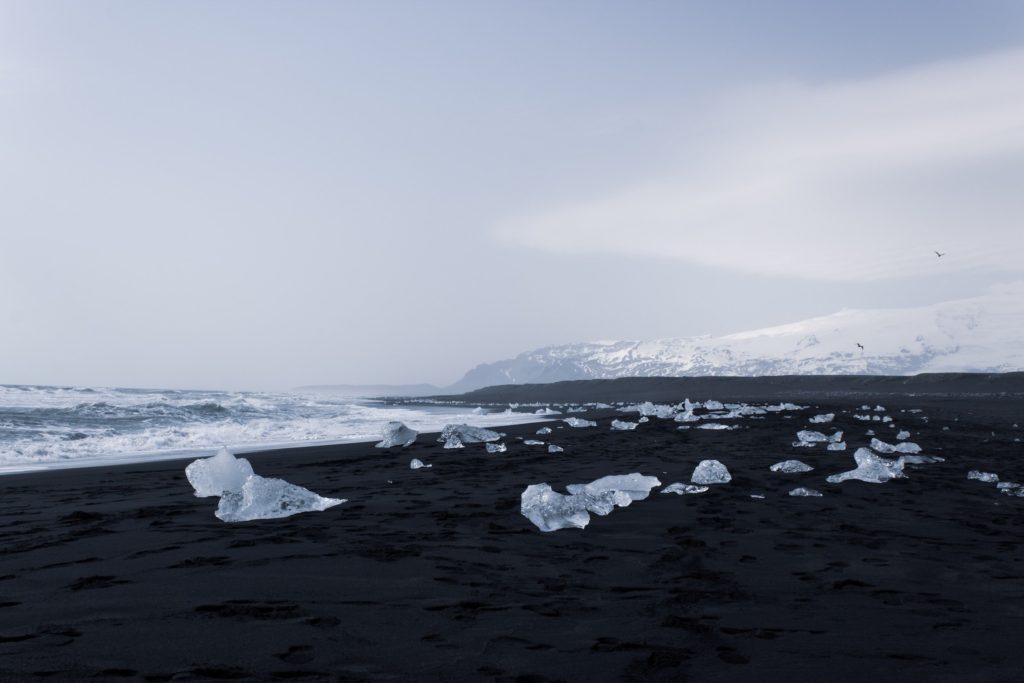
12) See Lava Erupt from a Volcano
Putting the fire in the Land of Ice and Fire, the highlight of many people’s trip to Iceland is seeing lava spew from an erupting volcano. Iceland is home to over 200 active volcanoes, making it one of the best places in the world to see lava flow from a volcanic eruption.
While eruptions can be unpredictable, there are a few volcanoes known for frequent activity, including Grímsvötn, Hekla and Katla. The most recent volcanic eruption was from Fagradalsfjall in August 2022 and it lasted 3 weeks. If seeing lava is high on your bucket list, you can either wait to book your trip to Iceland until after an eruption or hope your visit will coincide with one.
If there is flowing lava in Iceland during your visit, you should check Iceland’s Safe Travel website for all the latest eruption information. Eruptions can have devastating effects and be incredibly dangerous, so do your research and stay safe.
If there’s no lava to see, you can still explore the many ways volcanic activity shapes Iceland’s rugged landscape. Delve into subterranean lava caves, hike over lava fields or discover the inner workings of a volcano in lava tubes.
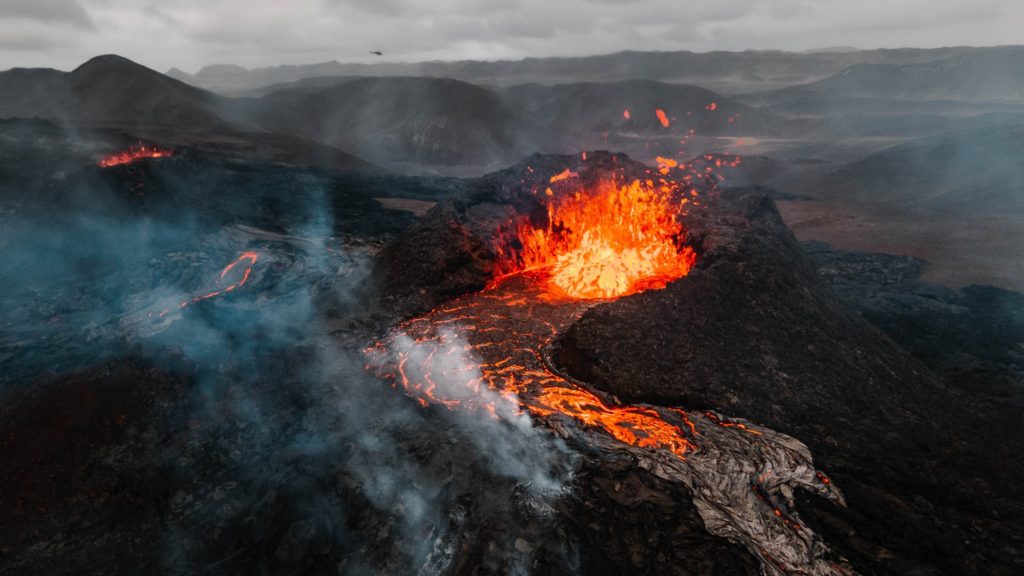
13) See the Plane Wreck
You’ve probably seen this famous shot before, but you might be thinking: how on earth did an abandoned aeroplane end up on a volcanic beach in Iceland?! Well, on 21st November 1973, a United States Navy DC3 plane ran out of fuel and crashed on the black beach at Sólheimasandur, on Iceland’s southern coast. Everyone in the plane survived, and the wreck was abandoned and left to rust on the beach, now making for a very eery photograph.
Visiting the plane requires a 4.3 mile (7km) round trip hike. There is a car park at the beginning of the trail, or you can take a shuttle, which runs every 30 minutes from 10:00-17:00. While this is a popular spot in Iceland for photographers, many other visitors have been left underwhelmed by the plane, so it’s up to individual opinion to decide if this spot is worth the effort.
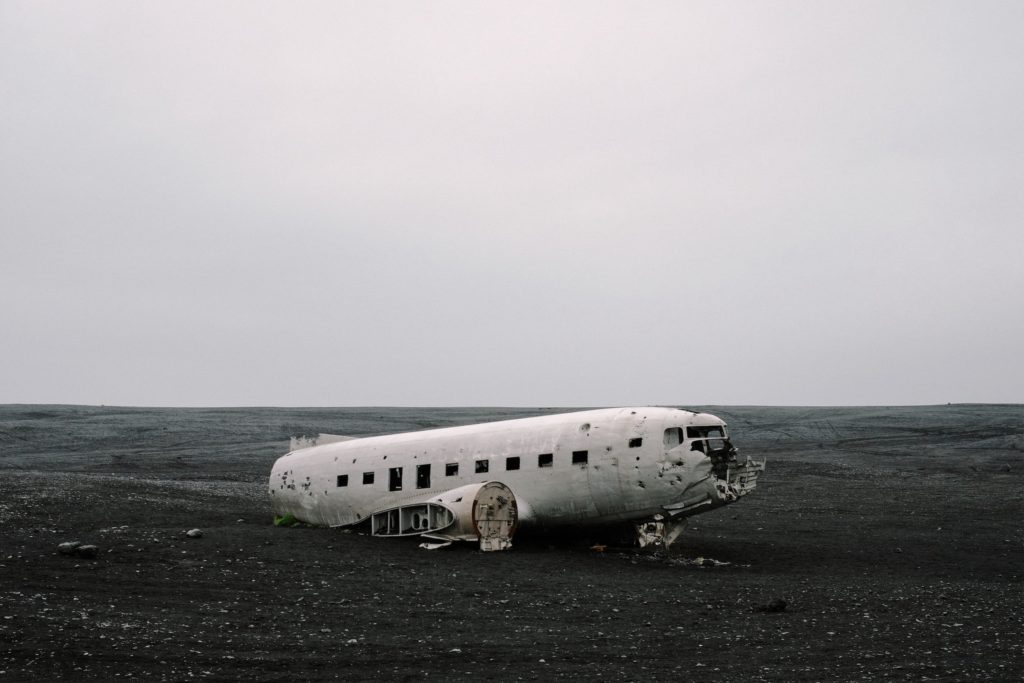
14) Go whale watching
If you’re a wildlife lover like us, chances are spotting a whale in the wild is on your Iceland bucket list. The best time to visit Iceland for whale watching is between April and October, with the peak being in the Summer months of June, July and August. Species such as Humpback, Blue, Fin, Minke, Sperm and Orcas can be spotted so chances of spotting at least one cetacean on your trip are high.
Whale watching trips typically take 3 hours and provide overalls to keep you warm, as well as a knowledgeable guide who will give you lots of informative commentary. Húsavík in Northern Iceland is the most popular place to take a whale watching trip in Iceland. But tours do also leave from the northern town of Akureyri too.
From Reykjavík, you can join a Wildlife Tour in a speedy RIB, where you have the opportunity to spot whales, dolphins, porpoises and puffins, as well as take in the main sights of Iceland’s capital from the water.
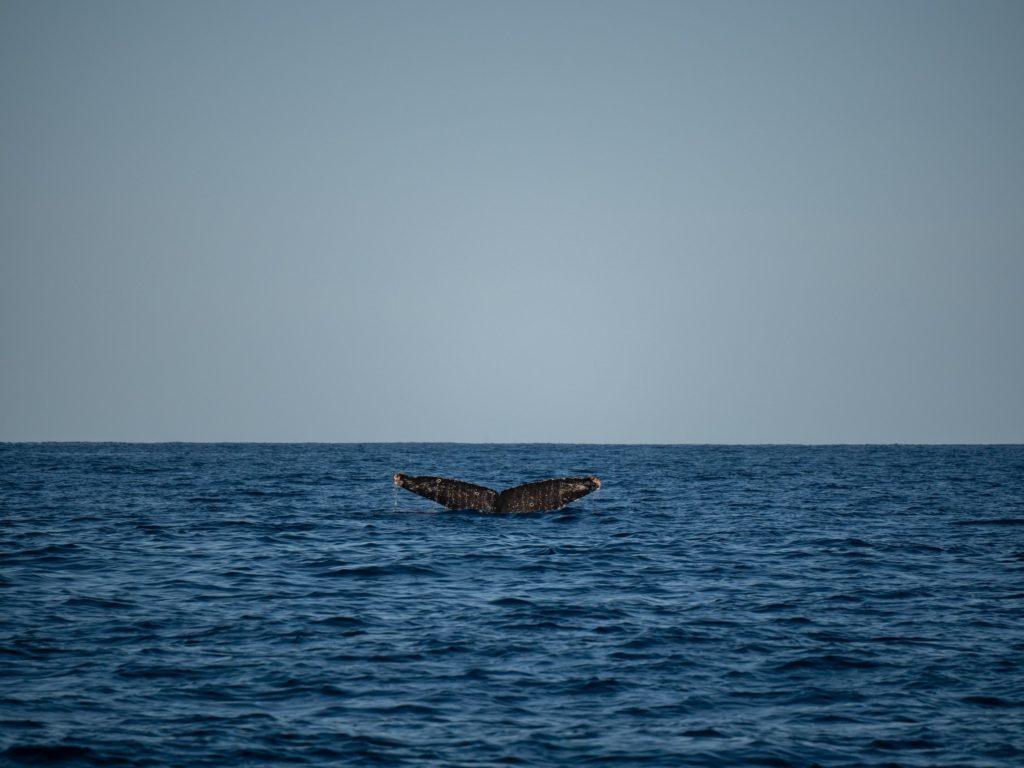
15) Dive between two tectonic plates
Calling all divers! Did you know in Iceland you can SCUBA dive between the European and North American tectonic plates?! Located within Þingvellir (Thingvellir) National Park, Silfra Fissure has the best underwater visibility in the world and is the only place in the world where you can dive between 2 continents! With clear waters giving you 100 metre (328 ft) visibility and a water temperature of 2°C (35°F), this is an activity not to miss off your Iceland bucket list.
Don’t worry if you’re not PADI certified. You can also join a Snorkel Tour of Silfra Fissure with free underwater photos! And if you’re coming from the capital, consider combining snorkelling Silfra Fissure with a Golden Circle tour, as Þingvellir Park is one of the three main stops on the route anyway.

16) Cruise through the Westfjords
Also known as Vestfirðir, the Westfjords is a large peninsula in north-western Iceland. Situated on the Denmark Strait, facing the east coast of Greenland, this is one of the least visited parts of Iceland and is perfect for people who like to get off the beaten path. Featuring vast landscapes, towering fjords (long, narrow inlets with steep cliffs, created by glaciers), expansive beaches, hot pools, waterfalls and quaint villages, Iceland’s Westfjords rival Norway’s world-renowned fjords.
The Westfjords are also one of the best places in Iceland to see wildlife. The Hornstrandir Nature Reserve is one of the best places in Iceland to see an arctic fox, and is also home to animals like seals and tens of thousands of seabirds, such as puffins.
It’s possible to fly to Hornstrandir from Reykjavík, while it can also be reached by ferries from Isafjordur and the Strandir district. It’s also possible to book tours of the Westfjords. Due to heavy snowfall in the winter months, the best time to visit Iceland’s Westfjords is between May and October.

17) Rauðasandur Beach
Most beaches in Iceland are made up of volcanic black sand, but in the Westfjords, the beaches range from golden to pink. Also called Red Sands Beach, Raudasandur Beach lies on a remote corner of Iceland’s west coast. A sprawling 6-mile (10km) expanse of red sand, Raudasandur is perfect for those who like long walks and photography. Backing onto the Látrabjarg Peninsula, the beach is surrounded by high cliffs and grasslands. One such area is Látrabjarg Bird Cliffs, the largest seabird cliff in Iceland, and one of the best places to see puffins. And in the summer months, seals can be seen basking on the sandy shore.
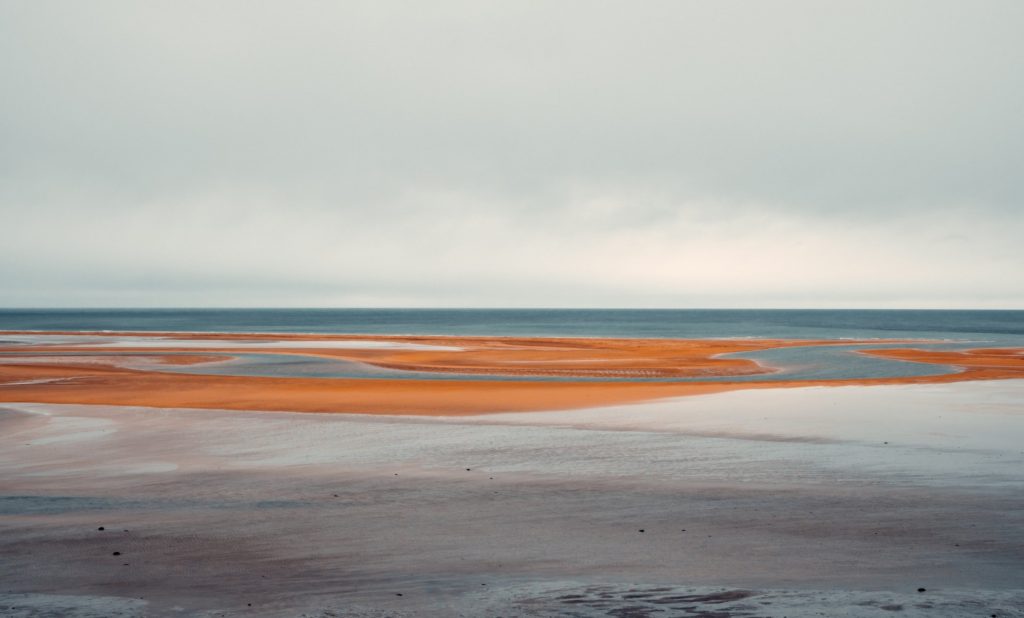
18) Spot Puffins
Puffins are iconic little seabirds with colourful beaks and orange legs that spring to mind immediately when someone says ‘Iceland’. There are actually 3 different species of puffin in Iceland: the Atlantic puffin (common puffin) is the most famous, while the horned puffin and tufted puffin are less common. The best time to see puffins in Iceland is between April and September, when they can be found in their nesting grounds, while the peak is between May and August. You may be wondering where the best places to see puffins in Iceland are. Well, we’re here to tell you.
Puffins can be found on sea cliffs, where they burrow into the rock. As we mentioned above, Látrabjarg Bird Cliffs are a fantastic place to spot puffins, while the Westman Islands, or Vestmannaeyjar in Icelandic, are home to the world’s largest puffin colony. Confusingly, the Westman Islands actually lie off the south coast of Iceland, near the town of Vík. You can take the ferry over and explore the island on foot, or take a boat tour out of Heimaey harbour.
Nearby, Dyrhólaey Sea Arch forms a small cove that provides shelter for a colony of seabirds, as well as plenty of other seabirds. And down the coast, Ingólfshöfði Lighthouse within Vatnajökull National Park is also a great spot, although quite difficult to get to. You’ll need to join a guided puffin tour by tractor to see the puffins at Ingólfshöfði.

The northern peninsula of Tjörnes is also a great spot for puffin-spotting. Just over a 1-hour drive from Akureyri and only 15 minutes from Húsavík, the walking trails that leave from the lighthouse provide great vantage points while an observation deck has been installed at Hringsbjarg cliff.
The best places to see puffins from Reykjavík are the islands of Akurey and Lundey. Nestled in Faxaflói Bay, Aukrey and Lundey (literally called Puffin Island) are nesting grounds for puffin colonies and the best chance to see puffins from the capital. You can join an eco-certified boat tour from Reykjavik’s Old Harbour. Other seabirds you’ll likely see on a puffin tour include northern fulmars, gulls, Arctic terns, and black guillemots.
Fun fact: A baby puffin is called a puffling.
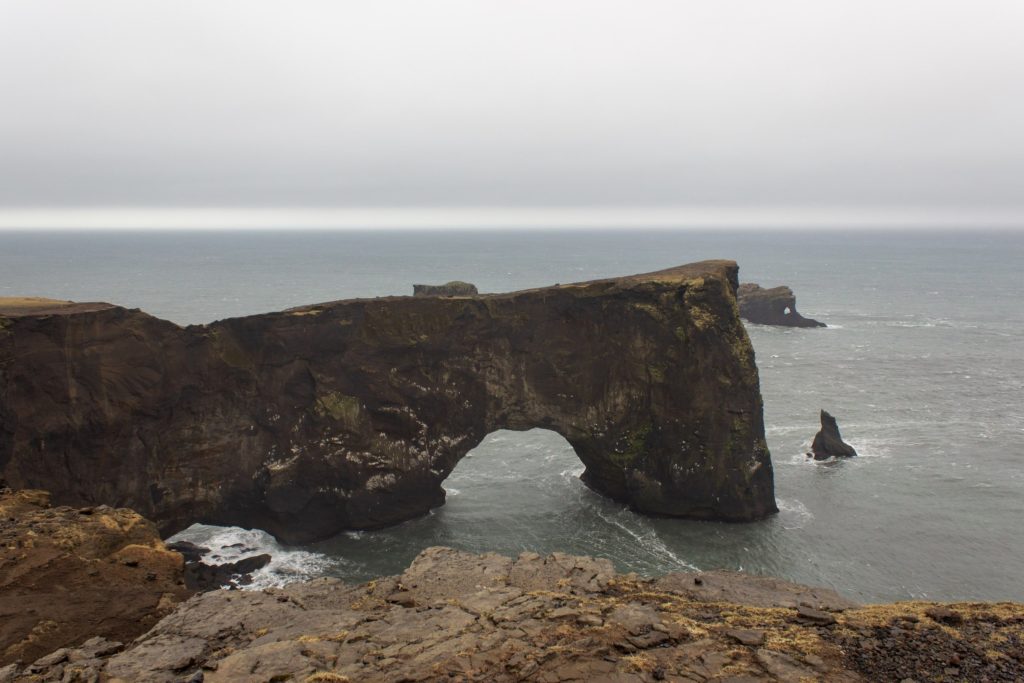
19) Find Reindeer in the Eastfjords
From the west to the east, Iceland’s Eastfjords is one of the least visited areas in the country, which means it’s unspoiled by tourism. Of the country’s total population of 335,000 people, approximately only 3.2% live in the east. And this is also the best place in Iceland to see reindeer. In fact, East Iceland is the only region where where you can see reindeer roaming free. Reindeer aren’t native to Iceland, they were introduced by royal decree in the 18th century from Norway and Denmark, and only the population in the Eastfjords survived. If you’re a keen wildlife spotter then you’ll want to head to the towns of Seydisfjordur, Djupivogur and Egilsstadir.
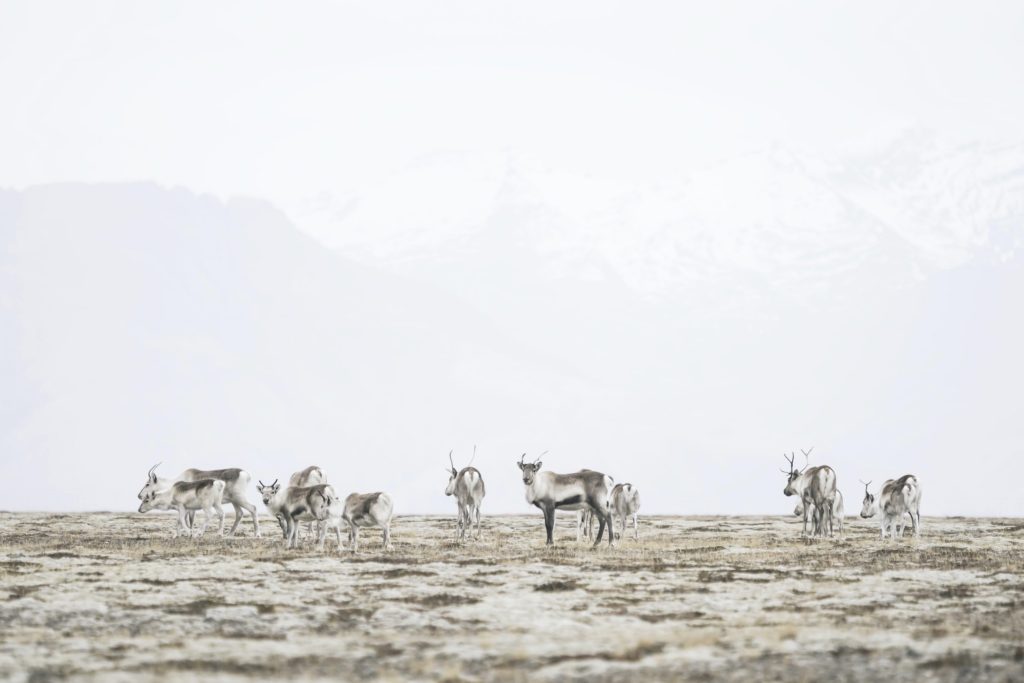
20) See Icelandic Horses
Sticking with the wildlife theme, one animal that’s easy to spot on your visit to Iceland is the Icelandic Horse. These unique horses are small, hardy and famous for their furry coats. Although they may be pony-sized, they’re actually horses and can be found roaming Iceland’s vast landscapes. Many travellers believe the horses are wild but in fact, almost all of Iceland’s horses are owned by farmers and groomers. It’s thought there are only 100 truly wild horses in Iceland.
The best place to see Icelandic horses is on your travels. You’ll likely spot them grazing in fields as you traverse Iceland’s Ring Road or the Golden Circle Route.
If you’re interested in getting closer to an Icelandic Horse, you should consider a horse riding tour through Iceland’s lava fields. Alternatively, tours can be taken from Vík, where you can ride along a black sand beach.

21) Visit Iceland’s Most Dangerous Black Sand Beach
Speaking of Vík, there’s a lot of other major Icelandic attractions in the area too. The famous and treacherous Reynisfjara Beach can be found on Iceland’s southern coast.
Famed for its tall, jagged rock formations that stand jutting out of the sea, Reynisfjara Beach is most known as a filming location in Game of Thrones Season 7. The dramatic landscapes bring tourists from all over the globe to see the basalt columns (Reynisdrangar) which, according to local folklore, were once trolls trying to pull ships from the ocean to shore. Reynisfjara Beach is prone to sneaker waves and rip currents, which have whisked unwitting tourists out to sea. If you do visit, be aware of the danger, never turn your back on the waves and keep a safe distance of at least 30 metres (100ft) from the shore.
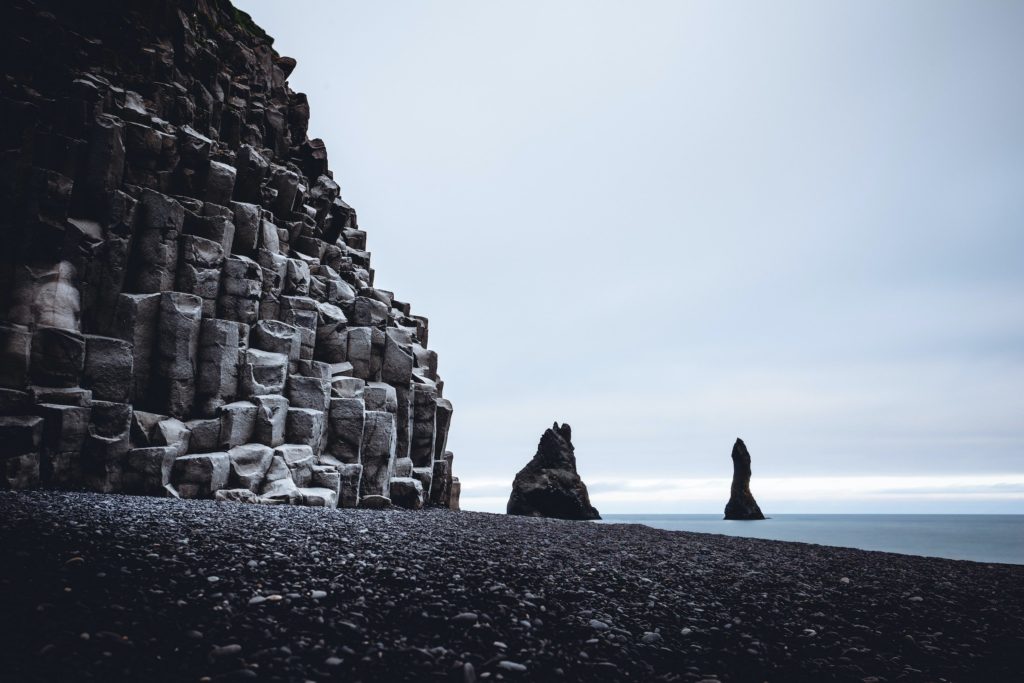
22) Ásbyrgi Canyon
Move over Horseshoe Bend, Iceland has its own Grand Canyon! Located in the north of Iceland, Ásbyrgi Canyon is a horseshoe-shaped depression that measures approximately 2.2 miles (3.5km) in length and 0.7 miles (1.1km) in width. The canyon is one of the most important sites in Icelandic folklore, and many myths and legends revolve around the area. Geologists estimate that the Canyon began to form between 8-10 million years ago. But it’s believed that the hooves of Odin’s eight-legged Icelandic horse came into contact with the ground here, creating Ásbyrgi Canyon.
Ásbyrgi Canyon is one of the best spots on the Diamond Circle Route, a 190-mile (310km) circular route in the north of Iceland. If you hire a car, you can drive the route in a day, or you can join a Guided Diamond Circle Tour, which will take you to all the main sites, with stops for epic photo opportunities.

23) Snæfellsjökull National Park
To the north of Reykjavík, Iceland’s western Snæfellsnes Peninsula is home to Snæfellsjökull National Park. Named after the famous 700,000-year-old, sub-glacial stratovolcano Snæfellsjökull, this national park is home to a wealth of diverse landscapes and natural attractions, including expansive lava tubes and lava fields. The volcano was actually the influence for Jules Verne’s Journey to the Centre of the Earth, making it one of the best things to see in Iceland. The park is also home to Djúpalón Black Sand Beach, where the remains of Edning, an Epine Fishing Trawler that was wrecked off the beach in 1948, can be found. The park is only a couple of hours’ drive from Reykjavík, making it an easy day trip from Iceland’s capital.

24) Road Trip
There are a few different routes to choose from when it comes to driving in Iceland. The most popular road trip is the Golden Circle, a circular route that’s easily accessible from Reykjavík. In the north, the Diamond Circle is a popular circular route that sees fewer tourists than the Golden Circle.
Those looking for adventure should consider driving Iceland’s Ring Road. An 825-mile (1,328km) route that traverses the whole country, the Ring Road covers most of Iceland and bypasses a lot of the main attractions. You should give yourself at least one week to do the loop, but two would give you lots of time to see all the main sights on the way. You can drive the circuit either way, but most people choose counter-clockwise and start with the Golden Circle. Many tourists drive the Ring Road in Iceland’s summer, between June and August, but it’s possible to still drive the Ring Road in winter too. Just be sure you are aware of road safety precautions and are comfortable driving in ice and snow. It’s recommended to hire a 4×4 car and check the weather and road conditions before setting off each day. Download the 112 Iceland app on your phone, which uses text messaging and can get through to emergency services when a voice call can’t. 112 is also the emergency number in Iceland.
If you’re keen to explore Iceland’s North Coast, you can drive the Arctic Coast Way. A 560-mile (900km) touring route in Northern Iceland, this drive winds along clifftops through 21 charming villages. It’s recommended that you drive from West to East for the best views and to be on the same side of the road as the sea.

26) Try Icelandic Food
No visit to Iceland is complete without sampling a variety of local delicacies and dishes. Iceland’s cuisine reflects its rugged landscape and a lot of the dishes are very simple. Lamb, fish and dairy are popular ingredients, while Iceland also offers more controversial meats, including puffin, shark, whale, horse and reindeer.
A few traditional dishes that you should try in Iceland include:
- Skyr – A thick and creamy Icelandic yoghurt, great with honey and pancakes.
- Rúgbrauð – Also known as rye bread, this is an Icelandic staple. Try it as an open sandwich or book in a Hot Spring Rye Bread Experience to learn more about how rye bread can be baked in Iceland’s volcanic black sand.
- Hot chocolate – The best way to warm up is with a cup of warm, chocolatey goodness. find the best hot chocolate ever in Kaffi Loki.
- Seafood – Try plokkfiskur (mashed fish stew), Harðfiskur (dried fish), Humar (Icelandic lobster/langoustine).
- Pylsur – A hot dog, but totally different to the American kind, Pylsur is mostly made from Icelandic lamb, along with a bit of pork and beef.
- Snúður – A cinnamon filled bread roll covered in chocolate, caramel, or sugar glaze.
- Pönnukökur – Icelandic pancakes! Thin crépe-like pancakes, usually served rolled up with a good amount of sugar or carefully folded with jam and whipped cream.
- Rúgbrauðsís – Rye bread ice cream can be also found at Kaffi Loki.
- Lakkrís – Icelandic liquorice.
- Brennivín – A distilled liquor, it is sometimes called Svarti dauði, meaning Black Death.
Foodies should consider joining a Walking Food Tour of Reykjavík, which includes sampling lots of Icelandic classics, including Icelandic cheeses, lamb, homemade ice cream, and the famous Icelandic hot dogs.
Find out more about the best places to eat and drink in Iceland later in this article.
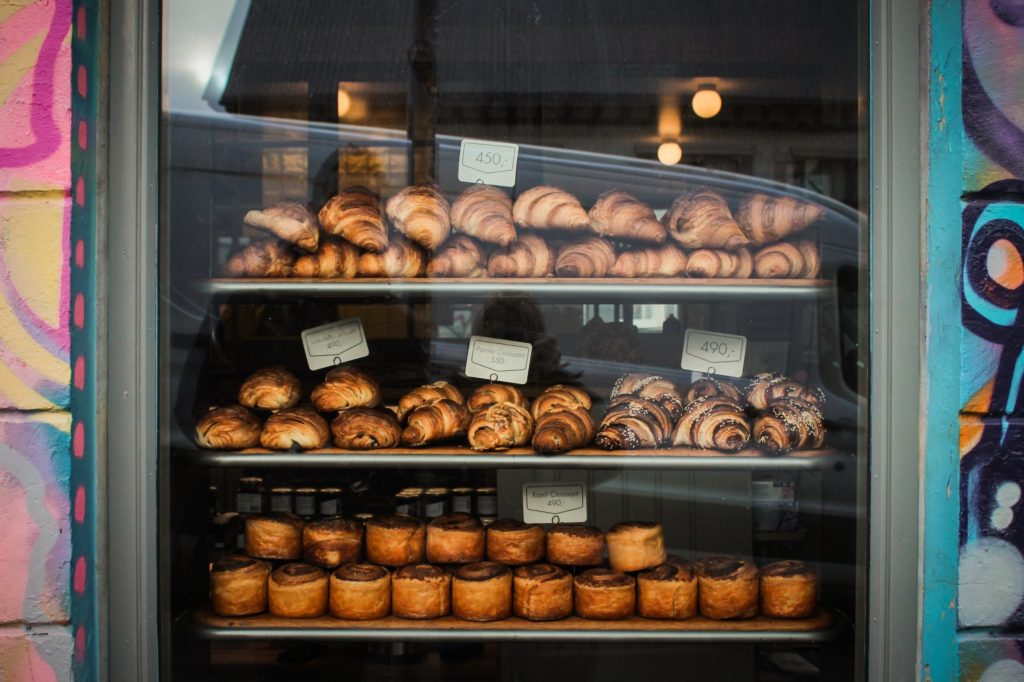
27) Bake Rye Bread in the Hot Earth
One of Iceland’s food staples is rye bread (rúgbrauð), a dense bread popular for making open sandwiches. In Iceland, you can actually bake rye bread in the volcanic earth, which is so hot it bakes it from a dough. Laugarvatn Fontana Spa offers the opportunity to try traditional Icelandic lava bread, where you will watch a dough preparation demonstration, learn about the history of geothermal bread, which is left up to 24 hours in the earth to bake, and be able to try some too.

28) Bathe in Beer
Another increasingly popular activity in Iceland is a visit to the infamous Beer Spa. Located in northern Iceland, not too far from Akureyri, The Beer Spa not only allows you to try local drafts, but you can bathe in them too! Opened in 2017, Iceland’s first Beer Spa allows you to bath in warm, young beer and live beer yeast, which apparently have a wealth of health benefits, including having a revitalising effect on skin and hair.

29) Attend an event
The people of Iceland are some of the happiest in the world. From 24-hour daylight known as the Midnight Sun, to long, dark winter days, Icelanders know how to have a good time and there’s a never-ending list of festivals, parties and events to keep everyone’s spirits high. Here are a few of the best annual events to attend in Iceland:
- Viking Festival – Featuring modern-day Vikings in traditional dress, this festival is held on the second weekend of June each year.
- Winter Lights Festival – held in February, this festival features dazzling art and light installations to celebrate Iceland emerging from the darkness of Winter.
- Iceland National Day – On 17 June Iceland marks the decision to become a republic in 1944 with parades and celebrations in Reykjavík and smaller parades around the country.
- Reykjavik International Film Festival (RIFF) – Occurring annually from late September into mid-October, the festival shows a wide range of dramas and non-fiction films from over 40 countries.
- Iceland Airwaves Music Festival – Held in November each year, this music festival features emerging and established national bands, as well as international performers.
- Reykjavík International Games – A sports event held in late January to early February each year.
- Reykjavík Food and Fun Festival – Featuring a limited-time menu, restaurants offer a set menu for a fixed price in late February or early March.
- Reykjavik Arts Festival – Held in May or June, international dance, theatre, design, and art displays are held across the city in one of the oldest and most respected art festivals in Europe.
- Reykjavík Pride – Celebrating the LGBTQ+ community and its supporters, friends, and family, Pride takes place on the second weekend in August.
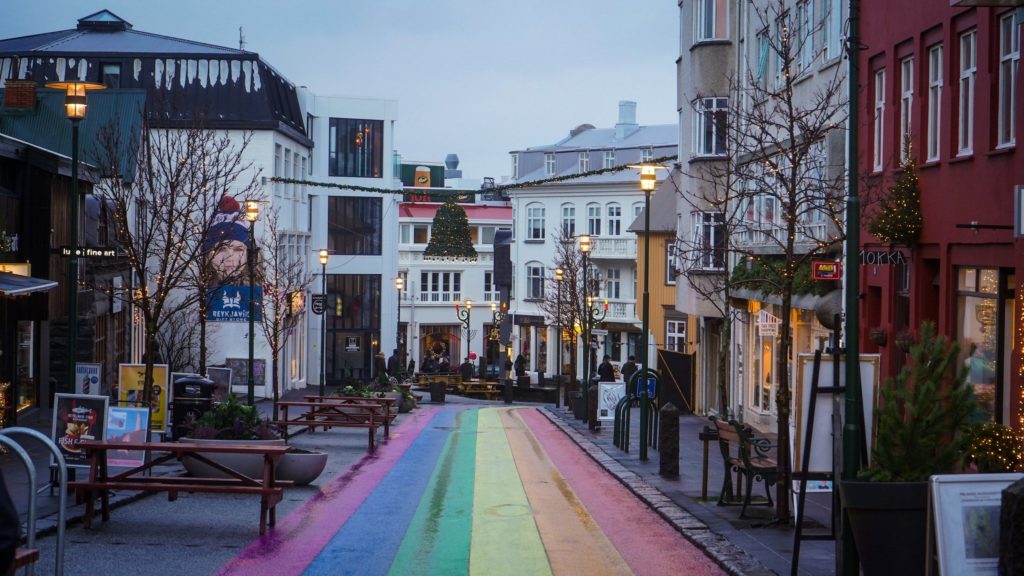
30) Visit Viking World
Located near Keflavík Airport, this Viking museum is famous for its replica of a 9th-century Viking ship called The Icelander. Other exhibitions the story of the Viking expansion across the North Atlantic, the Settlement of Iceland and an exhibition on Norse mythology and myths. Audio guides are available in four languages: Icelandic, English, German and Danish.
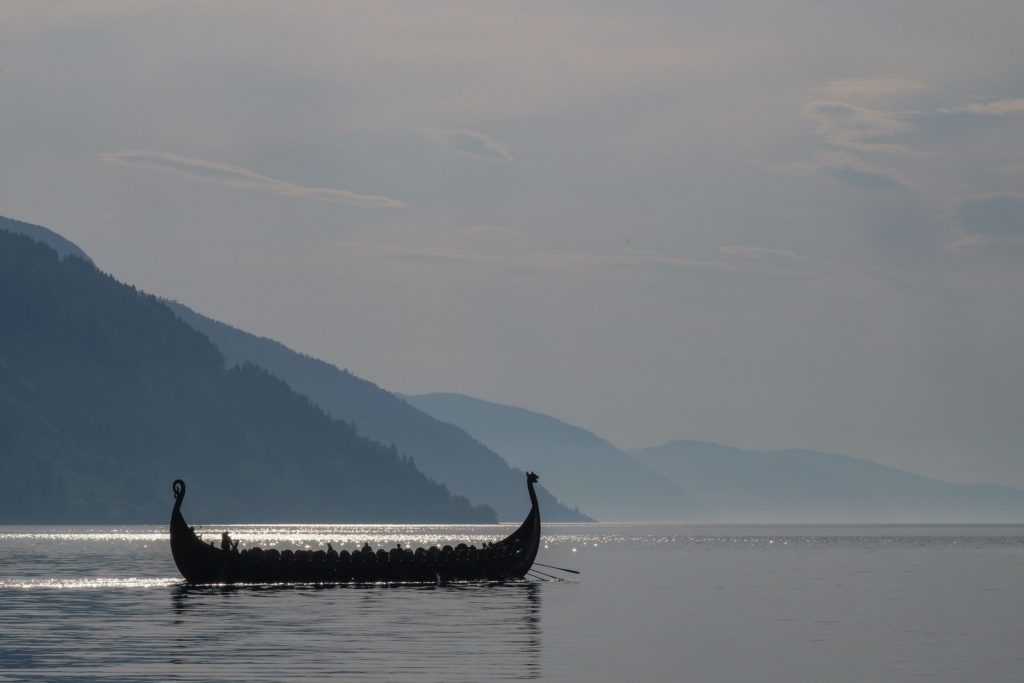
31) See the Game of Thrones Filming Locations
We’ve already mentioned quite a few filming locations for the hit TV series Game of Thrones, but if you’re a super-fan you should really consider taking a tour of the places in Iceland Game of Thrones was filmed. Leaving from Reykjavík, this fun, guided day tour will take you to all the most famous sites in Iceland where some of the most iconic scenes of the franchise were filmed. Hear stories from behind the scenes and discover the mythical land of Westeros as it was envisioned in George R.R. Martin’s A Song of Ice and Fire novels
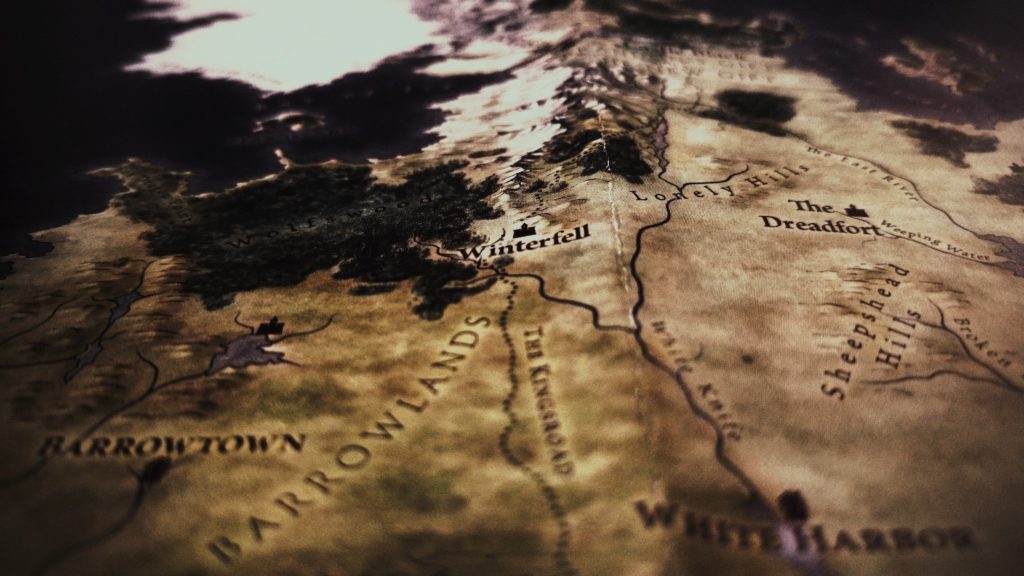
Free Saveable Iceland Attractions Map
Use the filters on the tab on the left hand side of the map to see attractions, accommodation, restaurants and more.
To save this map to your mobile Google Maps App:
Click the full-screen icon in the top right corner of the map. If your map doesn’t open automatically in Google Maps, click the three dots in the top right corner and select Open in Maps.
To find this map later, open the Google Maps app. Click the icon for Saved in the middle of the bar at the bottom of the screen. You can find this map under the Maps button.
To save this map to your Google Maps account on a browser:
Click the star icon beside the map name to save this map to your Google Maps.
Alternatively, click the full screen icon in the top right corner of the map. This will open the map in My Maps. Now open Google Maps in a new tab.
To find this map later, open the Google Maps website. Click the Menu (the three horizontal lines next to the search bar). Click Your Places. Click the Maps tab. This map will appear in the list.
Where to eat in Reykjavík
Reykjavík is one of the best food capitals in the world and offers a lot of traditional Icelandic cuisine. Here are some of the best restaurants in Reykjavík:
- Kaffi Loki – Located opposite the Hallgrímskirkja, Kaffi Loki has some of the best food in Reykjavík with an excellent view.
- Svarta Kaffið – Simple but so delicious we went twice, Svarta Kaffið specialises in soup in a bread bowl. They serve different flavours each day, including veggie options.
- Brauð & Co – Also known as The Cinnamon Bun Bakery, Braud & Co sells freshly made bread and baked goods.
- Vagninn – A food truck by the sea, specialising in fresh seafood and chips, as well as fish soup.
- Sægreifinn – Also known as the Sea Baron, try the lobster soup or haddock kebab.
- Apotek – Offers delicious and reasonably-prices cocktails.

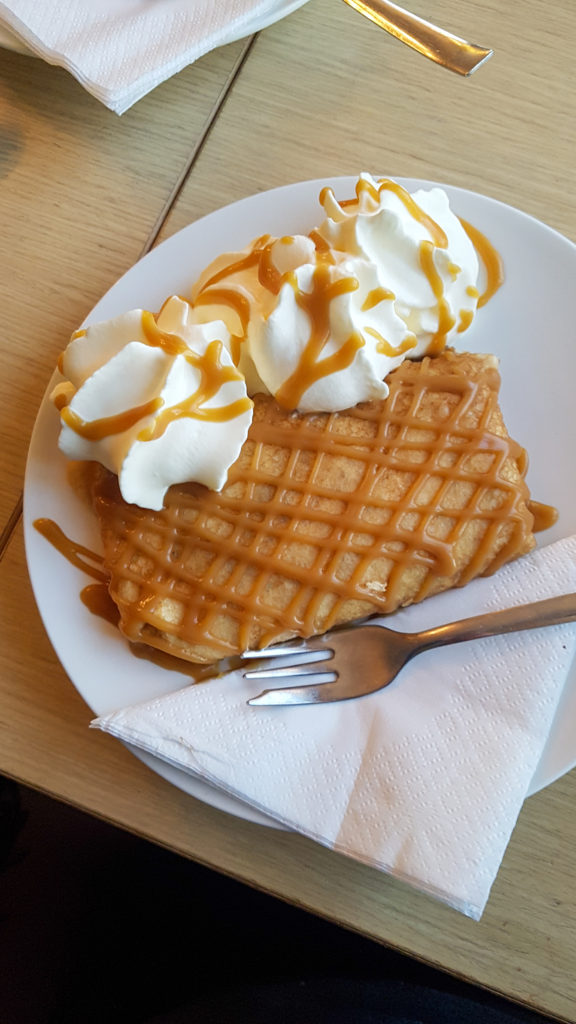
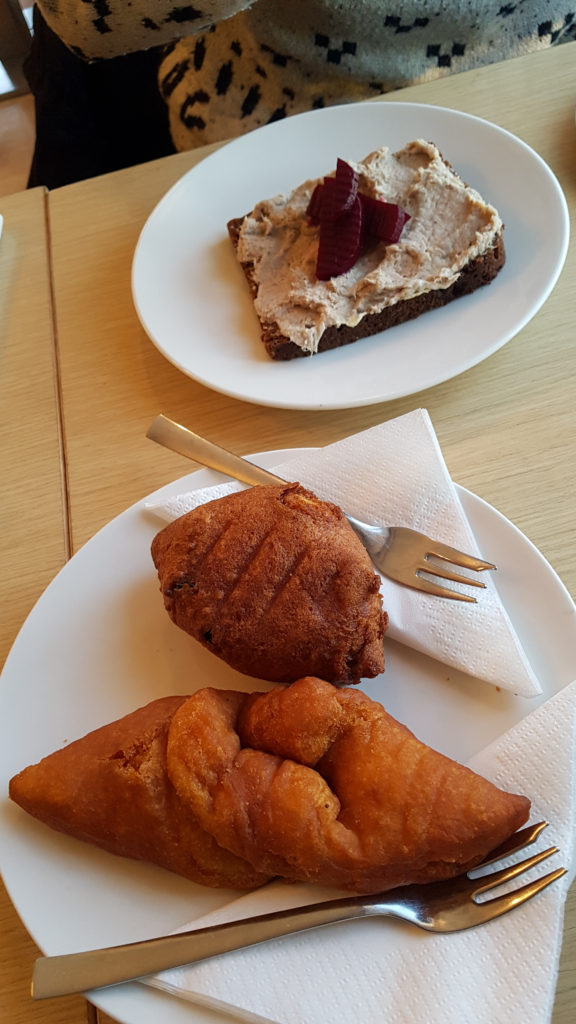
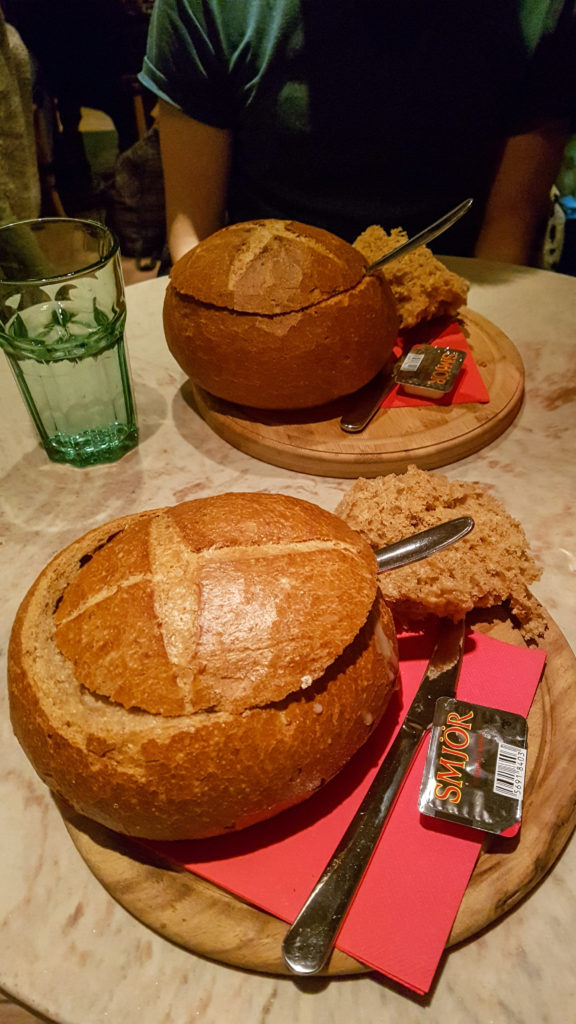
Where to eat in Iceland
And of course, if you’re leaving the capital, you’ll want to know where the best places to eat in the rest of Iceland are too. Here are our top picks:
Geysir Glíma Restaurant – Serves Scandinavian cuisine, such as fish soup, cod and braised lamb.
Friðheimar Farm – A visitor-friendly tomato farm, renowned for its fresh produce and tomato soup.
Flúðasveppir Farmers Bistro – The only mushroom farm in Iceland with a menu featuring homegrown produce.
Skjól Bar – Located at Skjól Campsite and offers pizza, burgers and snacks.
Gullfoss Tourist Information Centre – Features soups, sandwiches, salads and cakes.
Héraðsskólinn – A restaurant set within a boutique hostel, serving everything from trout to reindeer.
Drangar Restaurant Vik – Traditional Icelandic cuisine which prioritises seasonal and regional ingredients.
Sudur Vik – Scandinavian dishes in a warm, inviting setting.
Heimahumar “Local Langoustine” Truck – Street food truck located in the Jökulsárlón Car Park, offering Icelandic hotdogs and lobster soup.
Otto Matur & Drykkur – Cosy Icelandic restaurant, offering traditional dishes, seafood and vegetarian, vegan and gluten free options.
Rub 23 – An Icelandic-Asian fusion seafood restaurant, specialising in sushi and locally caught fish.
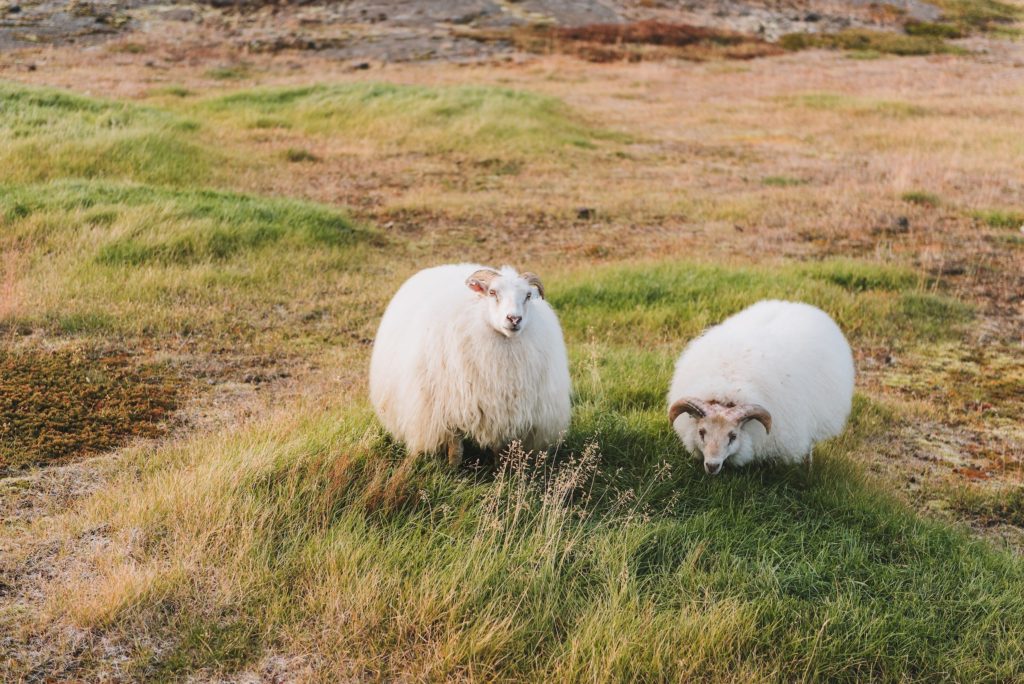
Getting around Iceland
Although not the cheapest transport option, hiring a car in Iceland is a popular way to get around and see the main sites. You’ll have the freedom to go where you want when you want. The roads in Iceland are good quality, if not narrow and winding in places, so are totally safe to drive. As you leave the beaten path, the roads become more gravelly and it’s recommended to have a 4×4. This is also a good idea for winter, when rain, snow and ice can affect the quality of the road and driving conditions may be challenging. Before driving in Iceland you should read up the things to know before you go and be aware of Iceland’s laws and safety tips.
Adventure seekers should consider hiring a campervan. We love a road trip by campervan and have chosen this as our method of transport in both Australia and Costa Rica. Hiring a campervan in Iceland is one of the best ways to immerse yourself in the rugged Nordic landscape. But you’ll need to visit in the warmer months of Spring, Summer and early Autumn, as a lot of campsites close during winter and roads will be tricky to traverse.
Reykjavík is extremely walkable. There’s also a good public transport system and you can use Stræto, a public transport app for planning journeys around both the capital area and around the island. Alternatively, you can join a Hop-On Hop-Off Bus Tour, which takes you around all the main sights. This is a good option for adventurers who are less mobile, or anyone wanting to escape walking around in the chilly winter air.

Where to stay in Iceland
There’s a huge variety of hotels and accommodation in Iceland but, as it is a very popular destination, they tend to book up quickly. Summer and the Christmas season are particularly busy times so, if you don’t book in advance, you’ll have a much more limited selection to choose from. If you’re planning to visit the more remote regions, such as the Westfjords, your choices are much more limited too.
Most visitors to Iceland choose to base themselves in the capital, Reykjavík. There’s a large variety of hotels within walking distance of the city centre, known as the Miðborg district. As you leave the city centre, accommodation becomes slightly cheaper. If you don’t mind a longer walk, using public transport or you have a car, consider staying in the districts of Vesturbær or Tún, Hlíðar. You can find a comprehensive list of the pros and cons of each district here, as well as our favourite hotels in Reykjavík.

Iceland is home to some weird and quirky accommodations too. Some of our top Iceland accommodation picks include:
Esjan – Unique guest rooms with mountain and sea views, set in refurbished busses.
Torfhús Retreat – Luxury Viking turf house with panoramic views of Southern Iceland and a hot spring bath.
Camp Boutique – Glamping-style bell tents on Iceland’s Southern coast, with a shared lounge, garden, sun terrace and private beach area.
Puffin Nest Capsule Hostel – Quirky Capsule Hostel on the Westman Islands, perfect for puffin-spotting.
Panorama Glass Lodge – Fall asleep under the stars in this intimate glass house, ideal for stargazing and watching the northern lights.
The Bubble Hotel – Dubbed the 5 Million Star Hotel, this glass dome allows you to fall asleep under Iceland’s captivating night sky.
Wilderness Center – A great place for families, this country hotel in east Iceland offers vintage-style rooms surrounded by farm animals and mountains.
Kirkjubaer Guesthouse – Built in 1923, this guesthouse used to be a church – in fact, it still looks like one – situated in the fishing town of Stodvarfjordur.
Árbakki Lodge Igloo House – Hard-top igloo domes in Northern Iceland, featuring river views, hikes and a vegetarian breakfast on request.
Those on a budget will be glad to know there are also hostels in Iceland. Most are concentrated to the cities of Reykjavík and Akureyri, but there are also options dotted around the country, as well as one at Keflavík Airport too. If you’re travelling as a family or group, you might like to consider a self-catering property. Airbnb is becoming increasingly popular, while Vrbo is widely used by locals to list their own properties.
Camping in Iceland is an excellent way to immerse yourself in nature and truly experience the Nordic countryside, but there are a few things to be aware of. Wild camping is illegal, so you need to be prepared and only stay in designated campsites. Some parts of Iceland are off-limits to campers, including Alafoss, Dimmuborgir, Dyrholaey, Fjallabak, Hverfjall, Kirkjugolf, Myvatn and Jokulsargljufur. NorCamp is a great resource for finding campsites and they have an app too. Bear in mind that a lot of campsites close in winter, so you’ll want to plan a visit in summer if you’re interested in camping. For a full list of campsites along the Golden Circle route, check out the where to stay section in our Thorough Guide to Iceland’s Golden Circle.

How to get to Iceland
Since Iceland is an island, flying in is by far the easiest and quickest way to arrive. Many international airlines fly directly to Iceland, including Icelandair, easyjet, Jet2, British Airways, American airlines and TUI. You’ll find the cheapest flights to Iceland fly into Keflavík International Airport.
To get to Reykjavík from the airport, it’s which is a 45-minute drive. There are several options to choose from when taking an Iceland Airport Transfer. You can take a taxi, but it’s going to set you back over $100. A cheaper option includes taking the Flybus, which offers a comfortable bus transfer with Wi-Fi and bag storage.
Many cruises also stop at Iceland while the M/S Norröna Ferry sails weekly from Denmark to Iceland via the Faroe Islands.
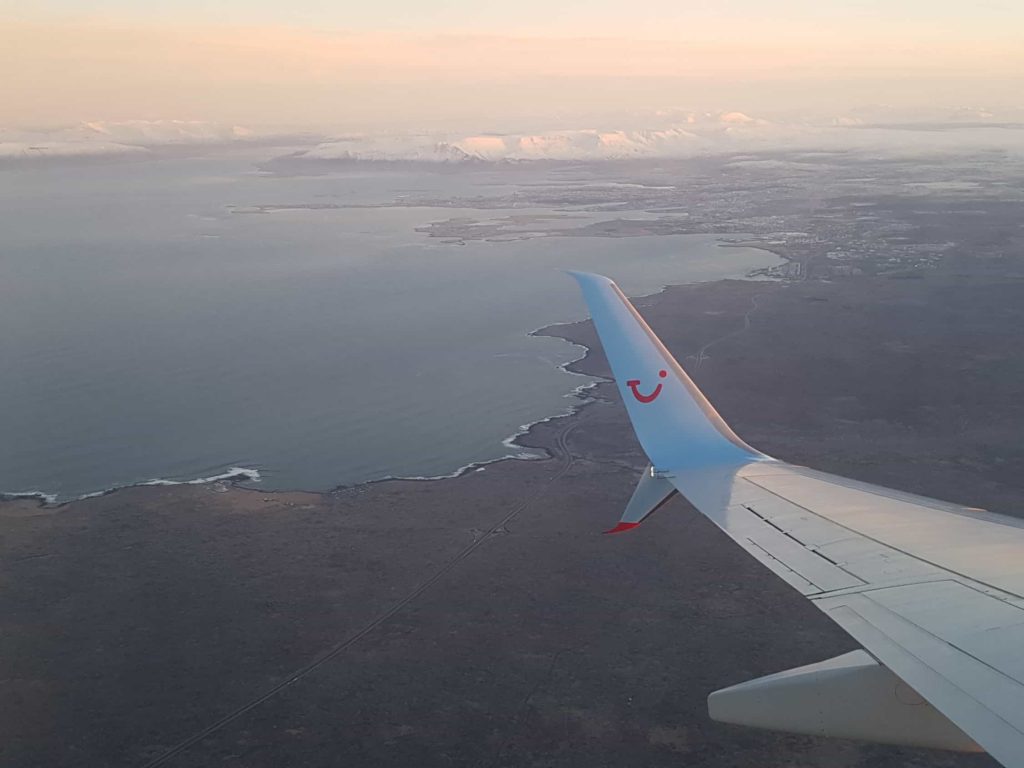
Package Holidays to Iceland
If you want to save yourself the effort of planning your trip, and being responsible for changes if anything goes wrong, you might like to consider booking a package holiday. Holidays to Iceland come with a variety of lengths and prices and each holiday provider will include different excursion and accommodation options. If you’re a UK traveller, we’d recommend checking out TUI. They not only offer a range of flights to Iceland, but also include a variety of hotels and excursions too. When we visited Iceland in 2017, we discovered that a TUI package of flights, hotel, airport transfers and two excursions was cheaper than booking it all ourselves! And you have the added benefit that all of TUI’s holidays are ATOL-protected, they have friendly representatives to assist you and a useful app with a wealth of resources to answer any questions you might have.
You can book your next trip to Iceland with TUI here, from as little as £471 per person!
Those travelling from outside Europe might wish to consider booking an Iceland Vacation Package with Icelandair.

Is Iceland expensive to visit?
The short answer to this is: yes. Iceland is the third most expensive country in the world so you’re going to need to manage your money when visiting. Some things are much more expensive than others, so it’s very possible to travel Iceland on a budget. While alcohol may be incredibly expensive, a lot of things to do in Iceland are actually free. Whether it’s doing a DIY walking tour of Reykjavík, or seeing the many wondrous natural attractions Iceland has to offer, there’s no reason a trip to Iceland should break the bank. Depending on how much you wish to do, the average price of a trip to Iceland is between $100-$200 a day.
Here are a few tips to save money while travelling in Iceland:
- Travel in off-season when prices are lower
- Choose hostels over hotels
- Choose public transport over taxis
- Choose accommodation that is further from the main attractions
- Self-cater and eat out less
- Shop at Bónus, Iceland’s cheapest supermarket
- Depending on how much you want to see, hiring a car may be cheaper than taking a lot of day tours
- If you hire a car, consider camping or hiring a campervan instead
Find more money saving tips in our guide: How to Travel on a Budget!

Do you need a visa to visit Iceland?
Iceland is part of the Schengen Area. The area comprises of 26 European countries who have abolished all passport and other types of border control, meaning you can move freely between countries within the area. You still need to have your passport stamped upon entry and exit of the Schengen Area.
Citizens of some countries, including UK, USA, Canada and Australia, do no need a visa to enter the Schengen Area, but there are certain requirements: You do not need a visa for trips to Iceland if you’re staying for 90 days or less in a 180 day period AND you’re visiting as a tourist.
Citizens of other countries may need to apply for a visa to enter the Schengen Area. You can check if you need a Schengen Visa here.
You should also always check the advice of your government’s foreign office, and any entry requirements:
Iceland entry requirements for UK tourists
Information on visiting Iceland for US citizens
Useful resources – Iceland apps and websites
For checking the weather: Veður
Google Play: Download here
App store: Download here
For Emergency Services: 112 Iceland
Google Play: Download here
App store: Download here
For driving in Iceland: SafeTravels
Google Play: Download here
App store: Download here
Find more apps and websites that are useful for driving in Iceland in our Golden Circle Self-Drive Road Trip Itinerary.
For Northern Lights Hunting: My Aurora Forecast
Google Play: Download here
App store: Download here
For hiking: WAPP
Google Play: Download here
App store: Download here
For camping: NorCamp
Google Play: Download here
App store: Download here
For booking accommodation: Booking.com
Google Play: Download here
App store: Download here
For public transport: Strætó
Google Play: Download here
App store: Download here
For parking: Parka
Google Play: Download here
App store: Download here
For Thingvellir National Park: Thingvellir National Park
Google Play: Download here
App store: Download here
For hot springs: Iceland Hot Springs Map
Google Play: Download here
App store: Download here
For fun: Iceland Film Locations
Google Play: Download here
App store (Game of Thrones alternative): Download here
For communicating: Icelandic Phrasebook
Google Play: Download here
App store (alternative): Download here
For cheaper cocktails: Appy Hour & Appening Today
Google Play: Download here
App store: Download here
To track your flight: FlightAware
Google Play: Download here
App store: Download here
For photographers: The Photographer’s Ephemeris
App store: Download here
Read next:
The Ultimate Self-drive Golden Circle Road Trip Itinerary
The Thorough Guide to Iceland’s Golden Circle
The Thorough Guide to Reykjavík
The Best Stockholm Budget Itinerary with Prices
Check us out on social media!

